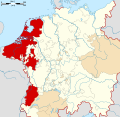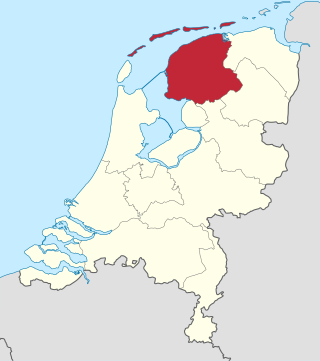
Friesland, historically and traditionally known as Frisia, named after the Frisians, is a province of the Netherlands located in the country's northern part. It is situated west of Groningen, northwest of Drenthe and Overijssel, north of Flevoland, northeast of North Holland, and south of the Wadden Sea. As of January 2023, the province had a population of about 660,000, and a total area of 5,753 km2 (2,221 sq mi).
The Union of Utrecht was a treaty signed on 23 January 1579 in Utrecht, Netherlands, unifying the northern provinces of the Netherlands, until then under the control of Habsburg Spain.
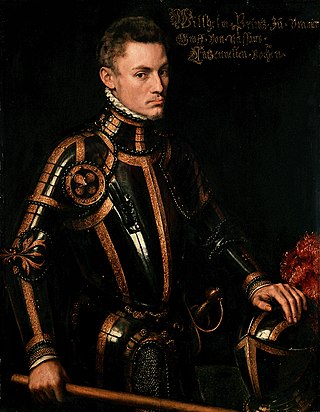
In the Low Countries, a stadtholder was a steward, first appointed as a medieval official and ultimately functioning as a national leader. The stadtholder was the replacement of the duke or count of a province during the Burgundian and Habsburg period.

Frisia is a cross-border cultural region in Northwestern Europe. Stretching along the Wadden Sea, it encompasses the north of the Netherlands and parts of northwestern Germany. Wider definitions of ‘Frisia’ may include the island of Rem and the other Danish Wadden Sea Islands. The region is traditionally inhabited by the Frisians, a West Germanic ethnic group.

The counts of Holland ruled over the County of Holland in the Low Countries between the 10th and the 16th century.

The Burgundian Circle was an Imperial Circle of the Holy Roman Empire created in 1512 and significantly enlarged in 1548. In addition to the Free County of Burgundy, the Burgundian Circle roughly covered the Low Countries, i.e., the areas now known as the Netherlands, Belgium and Luxembourg and adjacent parts in the French administrative region of Nord-Pas-de-Calais. For most of its history, its lands were coterminous with the holdings of the Spanish Habsburgs in the Empire.

West Frisia is a term that, when used in an international context, refers to the traditionally Frisian areas that are located west of the Dollart. Along with East Frisia and North Frisia, it is one of the most commonly used subdivisions of Frisia. In its narrowest sense, the term is synonymous with the province of Friesland. Within the Netherlands, however, it is mostly used to refer to the region of West Friesland, located west of Friesland.
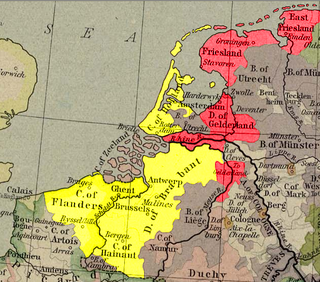
The Guelders Wars were a series of conflicts in the Low Countries between the Duke of Burgundy, who controlled Holland, Flanders, Brabant, and Hainaut on the one side, and Charles, Duke of Guelders, who controlled Guelders, Groningen, and Frisia on the other side.
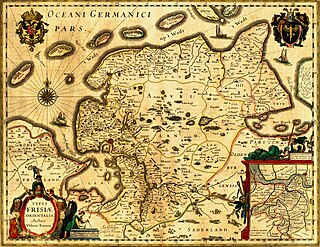
The County of East-Frisia was a county in the region of East Frisia in the northwest of the present-day German state of Lower Saxony.
The Saxon feud was a military conflict in the years 1514–1517 between the East Frisian Count Edzard I, 'West Frisian' rebels, the city of Groningen, and Charles II, Duke of Guelders on the one hand and the Imperial Frisian hereditary governor George, Duke of Saxony – replaced by Charles V of Habsburg in 1515 – and 24 German princes. The war took place predominantly on East Frisian soil and destroyed large parts of the region.
The Peace of Grave was signed on December 10, 1536, during the Guelders Wars between Charles II, Duke of Guelders and Charles V, Holy Roman Emperor.
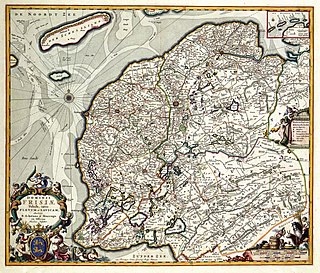
The Seignory of Frisia or Seignory of Friesland was a feudal dominion in the Netherlands. It was formed in 1498 by King Maximilian I and reformed in 1524 when Emperor Charles V conquered Frisia.
The Battle of Heiligerlee was a battle during the Guelders Wars, in which the Danish allies of Charles of Guelders, under command of Meindert van Ham, were defeated by Habsburg forces under Georg Schenck van Toutenburg.

The Lordship of Utrecht was formed in 1528 when Charles V of Habsburg conquered the Bishopric of Utrecht, during the Guelders Wars.

The County of Drenthe was a province of the Holy Roman Empire from 1046, and of the Dutch Republic from 1581 until 1795. It corresponds to the area west of the lower Ems, today the eponymous province of Drenthe in the Netherlands.

The siege of Niezijl was a siege of the town of Niezijl that took place between 3 and 24 October 1581 in the Dutch States, during the Eighty Years' War and the Anglo-Spanish War (1585–1604). The Spanish under Colonel Francisco Verdugo laid siege to the place after his victory at the battle of Noordhorn but the siege failed and Verdrugo retreated leaving the English and Dutch under John Norreys and William Louis respectively the victors.

The siege of Groningen was a two-month siege which commenced on 19 May 1594, and which took place during the Eighty Years' War and the Anglo-Spanish War. The Spanish-held city of Groningen was besieged by a Dutch and English army led by Prince Maurice of Orange. The Spanish surrendered the city on 22 July, after a failed relief attempt by the Count of Fuentes.

The Ten Years were a period in the Eighty Years' War spanning the years 1588 to 1598. In this period of ten years, stadtholder Maurice of Nassau, the future prince of Orange and son of William "the Silent" of Orange, and his cousin William Louis, Count of Nassau-Dillenburg and stadtholder of Friesland as well as the English general Francis Vere, were able to turn the tide of the war against the Spanish Empire in favour of the Dutch Republic. They achieved many victories over the Spanish Army of Flanders, conquering large swathes of land in the north and east of the Habsburg Netherlands that were incorporated into the Republic and remained part of the Netherlands into the present. Starting with the important fortification of Bergen op Zoom (1588), Maurice and William Louis subsequently took Breda (1590), Zutphen, Deventer, Delfzijl, and Nijmegen (1591), Steenwijk, Coevorden (1592) Geertruidenberg (1593), Groningen (1594), Grol, Enschede, Ootmarsum, and Oldenzaal (1597)., recovering territories lost in 1580 through the treachery of George de Lalaing. Maurice's most successful years were 1591 and 1597, in which his campaigns resulted in the capture of numerous vital fortified cities, some of which were regarded as "impregnable". His novel military tactics earned him fame amongst the courts of Europe, and the borders of the present-day Netherlands were largely defined by the campaigns of Maurice of Orange during the Ten Years.
















